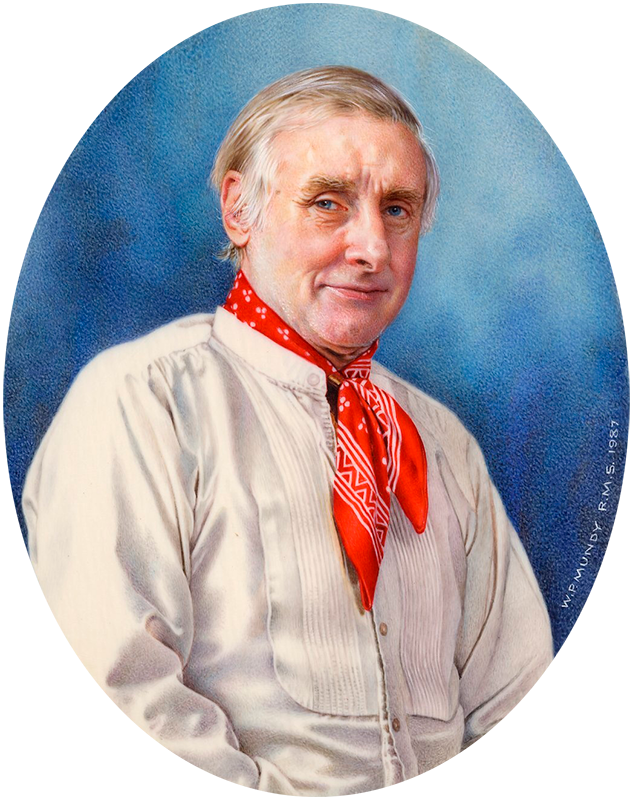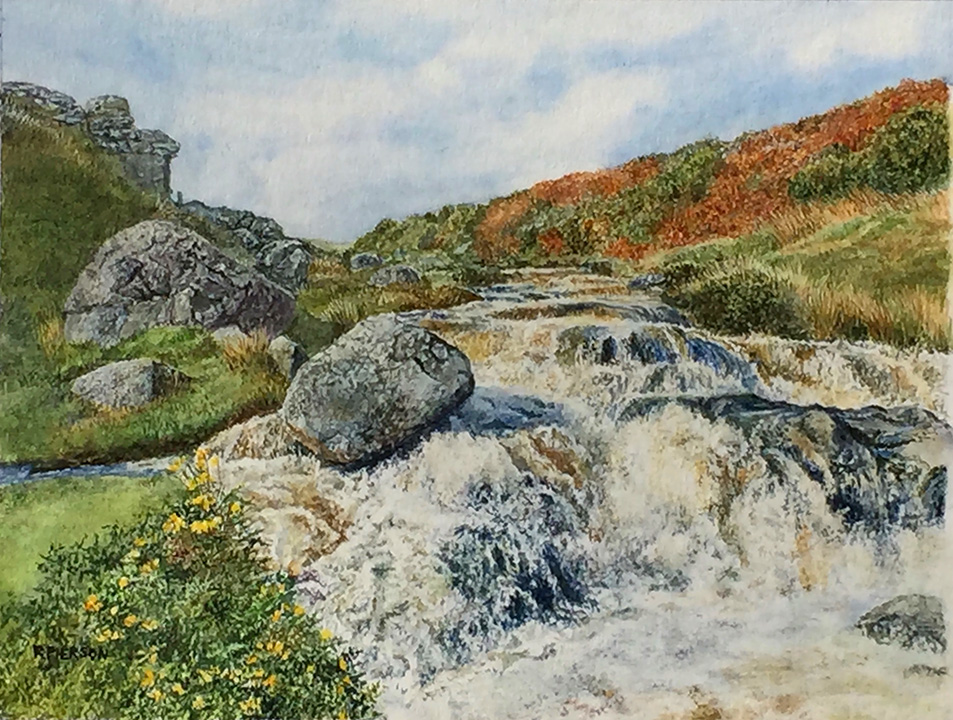Miniature Technique
Comparing Techniques
The history of portrait miniature painting in England goes back over four centuries; it followed on from the illuminated manuscripts in the 16th century which were painted on vellum.
Vellum is a beautiful soft surface to work on although it is not completely white.
In early portraits a layer of skin-coloured opaque water-based paint was painted over the facial area with the detail added over the top.
Vellum is slightly absorbent so can make the applied paint look dull although artists can overcome this by building up layers of colour.
NOTE: Hover over the images on this page to see more detail.

ARTWORK: ‘Spike Milligan’ by W.P.Mundy
The Technique
At the beginning of the 18th century ivory made its appearance and quickly became the preferred base. Its non-absorbent surface reflected light and gave the portraits a brighter, more luminous appearance.
Paint is applied using tiny dots known as stippling and the technique has been synonymous with watercolour portrait miniatures up to the present day although ivory has been replaced with synthetic ivory, or ivorene.

ARTWORK: – ‘Girl with Blue Pendant’ by Michael Coe

ARTWORK: by Rosalind Pierson
As a landscape miniaturist, I have never used ivorene since for me it doesn’t suit the subject matter, and painting a sky would require either washes, or stippling, which can appear artificial and stiff. For many years Daler Rowney produced a Bristol board, an exceptionally versatile and resilient surface, ideal for landscapes and it was a very sad day when it was discontinued.
I now use Schoellershammer, a smooth hard paper surface backed onto board. It does have a linear grain which can show up after several washes, but is otherwise an acceptable replacement.
NOTE: Hover over the images on this page to see more detail.
The Finer Details
Some of the finest examples of stippling in watercolour can be seen in the portrait miniatures of William Mundy and Michael Coe.
You can find out more about them further down the page, and I am very grateful to them for allowing me to use examples of their work.
To compare the styles are two of my own landscapes, showing much heavier brushwork. The sky in the moorland scene is quite complex and is built up using controlled small washes, with stippling over the top.
In my view, there are two kinds of ‘stippling’ – the seen and the unseen, the ‘seen’ being the tiny brushstrokes to paint grass, leaves, water, etc. which require texture and identification.
Brushwork for grass for example, will not be the same as painting foliage on a tree, and water has so many forms that it has its own range. The brushstrokes may gradually change to smoother finer stippling for distant detail so that it does not intrude on the foreground.

ARTWORK: by Rosalind Pierson
NOTE: Hover over image to see more detail.
Feature on:
William Mundy
William ‘Bill’ Mundy is one of the world’s leading miniature portrait painters. Twice he has been awarded the ‘Exhibit of the Year’ prize at the Royal Academy of Arts Summer Exhibition in London for his larger paintings.
His sitters have ranged from Royalty and small children to famous personalities in the world of entertainment. His works, both in miniature and full-size, are represented in Royal, Public, and private collections throughout the world.
Bill Mundy has won all the major awards in the world for miniature portrait painting, and he lectures extensively on the subject.
Please visit his website for more details and examples of his work.

ARTWORK: ‘Ade Edmondson’ by W.P.Mundy
Feature on:
Michael Coe
Many miniaturists say that what attracted them to miniature painting was the love of small things and detail, and Michael is no exception. His early paintings were larger in size, around 10” x 8” and from the beginning watercolour was his chosen medium.
His first subjects tended to be birds and their nests, and he was particularly captivated by the intricate form of the nest. The backgrounds were painted in a loose watercolour wash since the size of the composition hardly lent itself to the same detail throughout.

ARTWORK: ‘Woman with silver necklace’ by Michael Coe
NOTE: Hover over image to see more detail.
NOTE: Hover over the images on this page to see more detail.
Making his Mark
Early success came in 1977 with his first small watercolour painting ‘Goldcrest with young’, which was hung at the Royal Academy Summer Exhibition, and he exhibited there again in 1978, but it was an illustration of a portrait miniature in a book on 19th century European art which caught Michael’s attention as a true expression of the finest detail and there began a passion to paint portrait miniatures.
One of his first attempts was to copy a miniature by John Smart, which perhaps gives an indication of his intended journey to perfection. His subjects were mostly friends and family and in 1991 his entry of his niece and nephew was exhibited at the RA.
During one visit to the Summer Exhibition he saw several miniature portraits by Sheila Sewell RMS and it was she who introduced him to the materials and suppliers required to paint miniatures.
Another contact, this time with Sue Burton, led to his introduction to the Hilliard Society of Miniaturists, and he has exhibited with both societies ever since.
Aiming for Perfection
For about a year Michael also worked as a freelance artist with a publishing agency on gardening magazine illustrations and more recently does occasional restoration work.
While early miniatures were painted on ivorine, Michael moved to vellum after seeing the work of Elaine Fellowes, and he remembers being impressed by the clarity and strength of colour she achieved in her paintings.
Vellum is quite absorbent and not completely white, and it can deaden a colour, but by building up multiple layers of paint this can be overcome. It is a deceptively simple explanation for the end result, and the process requires infinite patience and very many hours to achieve.
Michael is always aiming for perfection and those who admire his work believe he has already achieved it. While he does accept commissions, be prepared for a wait of anything up to six months, knowing however that the wait will be worth it.
Nicholas Hilliard described miniature portraits as ‘jewels to be held in the hand’, and this is a fair description of Michael’s work.
2023 Michael Coe Workshop
The Hilliard Society holds a one day workshop each year during its annual exhibition and Michael has kindly agreed to tutor at the workshop this year. It is a very rare opportunity for students who are interested in painting portrait miniatures, to learn from an exceptional artist. Numbers are limited so if you are interested, early booking is essential!